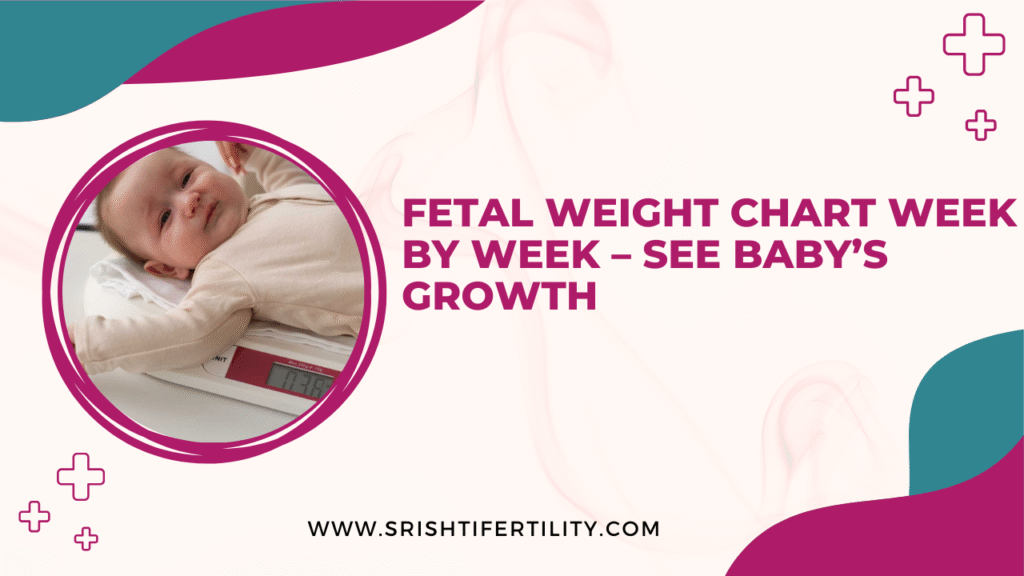Fetal Weight Chart Week by Week – See Baby’s Growth!
A Beautiful Journey Begins Pregnancy is an extraordinary journey—filled with anticipation, curiosity, and lots of questions. One of the most frequently asked questions by expecting parents is: “Is my baby growing properly?” Monitoring fetal growth is a crucial part of prenatal care, and understanding how your little one grows inside the womb week by week can be both reassuring and empowering. That’s where a fetal weight chart comes in. In this blog, we break down a detailed fetal weight chart week by week, help you understand growth patterns, and highlight how the experienced team at Srishti Hospital and IVF Centre supports you every step of the way. Let’s explore how your baby blossoms from a tiny dot to a cuddly bundle of joy! What Is a Fetal Weight Chart? A fetal weight chart is a medical reference tool that shows the average weight of a fetus at different stages of pregnancy. It helps doctors and parents understand whether the baby’s growth is on track. It’s important to note that every pregnancy is unique, and there may be slight variations. However, these charts offer a helpful guideline to assess your baby’s development. Fetal Weight Chart Week by Week Here’s a detailed week-by-week fetal development weight chart showing average fetal weight in grams and pounds: Week Average Weight (grams) Average Weight (pounds) 8 1 gram 0.035 oz 12 14 grams 0.5 oz 16 100 grams 3.5 oz 20 300 grams 10.5 oz 24 600 grams 1.3 lbs 28 1,000 grams 2.2 lbs 32 1,700 grams 3.75 lbs 36 2,600 grams 5.7 lbs 40 3,400 grams 7.5 lbs Please remember: These values are approximate. Your doctor may use ultrasounds, fundal height measurements, and Doppler imaging to assess actual fetal growth. Understanding Fetal Growth Milestones Each phase marks a significant milestone. Monitoring fetal weight ensures your little one is developing healthily and prepares healthcare providers for any necessary interventions. Is My Baby’s Growth on Track? Pregnancy is a journey filled with anticipation and questions — especially about your baby’s growth. Use this quick self-reflection checklist to assess whether everything seems to be progressing smoothly. (Reminder: This is a self-check guide, not a medical diagnosis. Always speak to your doctor for personalized advice.) ✅ Are you attending regular prenatal checkups? Regular prenatal visits are vital for tracking your baby’s development and your overall health. These appointments help your doctor monitor fetal growth, detect early signs of complications, and ensure timely vaccinations, screenings, and supplements (like iron and folic acid). Missing checkups can lead to undetected issues — so keep them a top priority. ✅ Has your doctor recommended any ultrasounds for fetal weight monitoring? Ultrasounds, especially during the second and third trimesters, are key tools for estimating fetal weight and size. Your doctor may schedule additional scans if there are concerns about growth patterns. These scans help detect conditions like IUGR (Intrauterine Growth Restriction) or macrosomia (excessive weight) early on, allowing for proper management. ✅ Are fetal kicks and movements consistent with your current pregnancy week? Feeling your baby move is one of the most reassuring signs of healthy development. Movements typically start between weeks 18–25 and become more noticeable and regular as pregnancy progresses. A sudden drop in movement or no movement at all should be reported to your doctor immediately. ✅ Have you experienced any sudden weight changes or abnormalities? Your own weight gain is a useful indicator of your baby’s growth. While every pregnancy is unique, sudden or excessive weight gain may signal conditions like gestational diabetes, while very little gain could indicate fetal growth concerns. Keeping a steady, doctor-approved gain is essential. ✅ Is your doctor concerned about intrauterine growth restriction (IUGR) or macrosomia (excessive fetal weight)? If your doctor has mentioned either of these terms, they’re monitoring your baby’s growth closely. Your Takeaway: If you answered “no” to any of the above, don’t worry—just bring it up at your next appointment at Srishti Hospital and IVF Centre. Our expert OB-GYNs are here to guide and support you. How Srishti Hospital and IVF Centre Supports You At Srishti Hospital and IVF Centre, we understand that every pregnancy is a unique story. Our dedicated team of specialists provides: We walk beside you through every heartbeat, every sonogram, and every exciting milestone—ensuring your baby’s growth is healthy and strong. FAQs About Fetal Weight Charts Q: Can fetal weight be measured accurately during pregnancy?A: Ultrasounds provide an estimated fetal weight (EFW) based on measurements of the baby’s head, abdomen, and femur. While not 100% exact, it’s a reliable method. Q: What if my baby’s weight is below the chart?A: Don’t panic! Genetics, nutrition, and other factors may cause small variations. Your doctor may suggest closer monitoring or additional scans. Q: Can a fetus be too big?A: A heavier-than-average fetus (macrosomia) may lead to delivery complications. If identified early, your care team can plan a safe birth method. Conclusion: Tracking Tiny Triumphs Your baby’s growth is a miraculous process, and each week brings you one step closer to holding them in your arms. Understanding the fetal weight chart week by week gives you insights, comfort, and a sense of progress. At Srishti Hospital and IVF Centre, we believe in empowering parents through education, compassion, and expert prenatal care. From the first ultrasound to the final push in the delivery room—we’re here for you and your little miracle. — 🌐 Ready to monitor your baby’s growth with the best care?Book your consultation with Srishti Hospital and IVF Centre today.
Fetal Weight Chart Week by Week – See Baby’s Growth! Read More »






